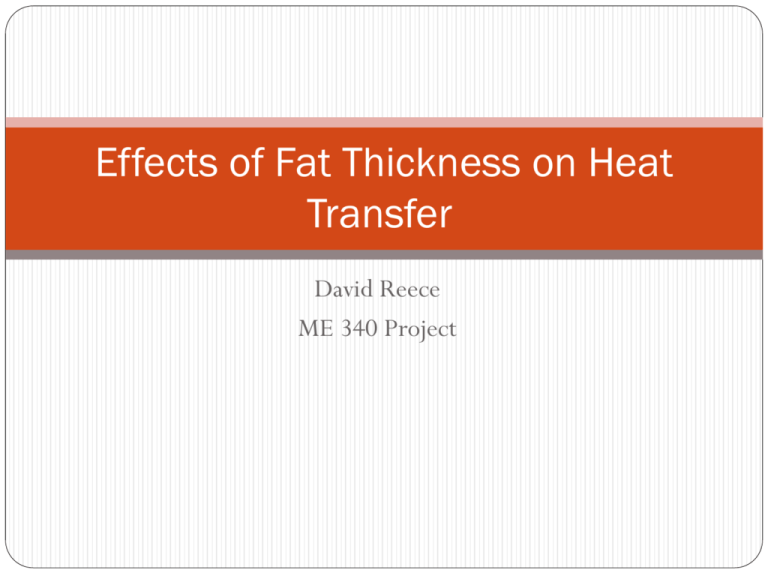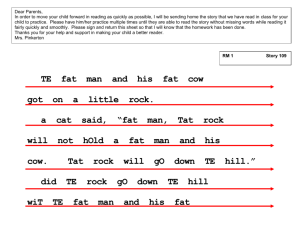Effects of Fat Thickness on Heat Transfer
advertisement

Effects of Fat Thickness on Heat Transfer David Reece ME 340 Project Introduction Problem: How much energy is lost at different temperatures with different thicknesses of fat? Objective: To investigate the effect of fat thickness on the amount of energy lost and how this might affect eating habits of people of differing physique. Heat Transfer Problem Human body was modeled as five cylinders, one for the torso and one for each arm and leg. The heat transferred through the head was neglected because of the lack of fat. Torso Inner Tissue Radius = 15 cm Length = 0.74 m Arms Inner Tissue Radius= 3.3 cm Length = 0.56 m Legs Inner Tissue Radius= 4.6 cm Length = 0.86 m Heat Transfer Problem Skin: Thickness 2.5 mm Heat Transfer Coefficient 0.37 W/m*K Fat Tissue: Varied Thickness (0.5 cm to 8 cm) Heat Transfer Coefficient 0.2 W/m*K Inner Tissue: Different Radii for Different Body Parts Constant Temperature = 37° C Equations Used For Solution Results Temp (°C (°F)) 32.2 (90) 22.2 (70) 10 (50) 0 (32) ΔT (°C) .5 cm Fat 1 cm Fat 2 cm Fat 4 cm Fat 8 cm Fat 207 124 72 42 26 4.8 (178) (107) (61.9) (36.1) (22.0) 639 383 222 130 79 14.8 (549) (329) (191) (111) (68.0) 1165 698 405 236 144 27 (1002) (601) (348) (203) (124) 1596 957 554 324 197 37 (1374) (823) (477) (279) (170) Results are in Watts and (Cal/Hour) Discussion The results show that with a fat layer thickness 16x bigger, an eighth the amount of heat is transferred. This means that a person with only ½ cm fat layer around the torso, arms, and legs, will use eight times the energy just keeping warm. People with thicker layers of fat are able to keep warm easy and thus need less calories for heating than the thinner people. This also means that they need to be more careful about how much they eat because they won’t use the energy as quickly as skinner people. Conclusion Analysis Shows: Large amount of heat used to simply stay warm Heat loss is significantly reduced with more fat Gaining weight may be advisable in colder climates Losing weight may be advisable in warmer climates (Consult doctor before either steps) Improvement Recommendations: Clothing Muscle exertion More accurate dimensions for appendages and other parts Add convection and radiation. References Atkins, P. and Jones, L. Chemical Principles:The Quest for Insight. W.H. Freeman and Company. 4, 2008. Incropera, Dewitt, Bergman, Lavine. Fundamentals of Heat and Mass Transfer.





